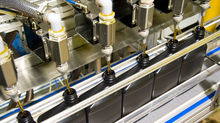Best Practices in Specialty Lubricant Manufacturing
The manufacturing of a complete compressor lubricant product line provides many challenges beyond formulating and performance validation. With such a large product offering including PAG, PAO, POE, Diester, Food Grade, Semi Synthetic, Partial Synthetic, Silicone and supporting Vacuum Pump Fluids as well as Blower Fluids, there are well over a dozen types of lubricants to manufacture. Consider then the need for various viscosities for most of these products including 32cst, 46cst, 68cst, 100cst and in some cases even heavier weighted oils. This breadth of products, totaling more than 50 separate formulations can cause a manufacturing staff’s head to spin.

ISO 9001 Certification
Regardless as to whether a lubricant manufacturer produces 10 gallons of a product or 10,000 gallons, their customers both expect and demand consistency. ISO certification ensures that a manufacturer has in place quality procedures and checks to assure consistency in production. The goal is to eliminate the possibility of deviations during production. A facility with stringent quality control, as certified by ISO, offers a consistent product across all blended batches.
ISO 9001 ensures the validation of each batches specifications to the standard set for that product. Samples are then retained for a predetermined time as reference of that batch as needed.
Best Practices for Blending
In support of ISO standards and to provide additional clarity, the Independent Lubricant Manufacturers Association (ILMA) has provided an outline of managing best practices for lubricant manufacturing. Most all compressor lubricant manufactures are members of ILMA, but participation in the following of these guidelines are sporadic. Two areas to highlight are product testing and sample retains.
ILMA aligns itself with ISO’s thoughts on product consistency by stating as part of product testing, each formulation should have a clearly identified quantity of ingredients with associated volumes along with a specific listing of required tests to validate the product has been manufactured properly to meet intended performance levels. Prior to manufacturing of finished lubricants, each base oil and additive should be evaluated against specifications for lot acceptance. After final blending, each product must then be tested as part of the finished goods validation process before shipment to the customer.

ILMA also reinforces the need for sample retains on all manufactured goods whether it be one pail or a full tank truck of fluid. Individual componentry variations, blending temperatures, mixing, residual fluid in production lines and other contamination can all effect finished product specifications. Testing each finished product and retaining a sample meets ISO 9001 procedures for ongoing validation of each batch.
Importance of Consistency
The keystone of quality is consistency, and the resulting ability to produce identical products repeatedly each time. There are many parameters that must be monitored to assure a consistent product.
Base fluid viscosity
Proper antioxidants at the appropriate level
Corrosion inhibitor package
Antifoam agent dispersal
Correct order of additization
Proper temperature for blending
Thorough product mixing at prescribed temperatures assures that the additives are dispersed through each pail or drum that is packaged from that batch.

Micro or Small Batch Blending
Small batches of finished lubricants can be commonplace in the compressor industry due to low demand. This includes batches of 330 gallons or less. The terms micro and small batch blending stem from a deviation in ISO’s preferred manufacturing process, performed by pouring the base fluid and additives into the final container that the product is to be sold in.
This process is similar to that of a paint store, where all cans contain a white base, and color pigments (additives) are then added. The paint store takes the finished container and places it into a shaker for vigorous mixing to ensure consistency throughout the can of paint. In lubricant blending, micro/small batch blending includes the base oil and an additive concentration being poured into the final packaging. With lubricants however, the final agitation step is typically not possible to achieve consistency through the finished product. In low ambient temperatures, this process can further deviate from the intended finished product specifications due to increased viscosities effecting flow rates as well as proper mixing.
This process results in each final package being its own unique blend or batch. Both the can of paint and a pail of lubricant are similar in that the equipment metering the additives is not perfect, leaving opportunity for error without final quality control. With the high number of pails and drums leaving each day, it is unreasonable for a retain sample to be taken from each of these containers, and certainly insufficient time to test each blend against the specification standard to ensure consistency.
For these reasons, it is usually preferable to work with a supplier who is capable of manufacturing in true blending vessels and performs quality control checks on each finished product. By adhering to the “best practice” standards of an ISO quality management system, SA Performance can help you grow your business with the peace of mind knowing you are providing the highest quality aftermarket oil available anywhere.
References
Best Practice for Blending and Handling Lubricant Products. ILMA 04/2006.























